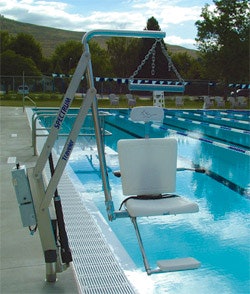
Sometimes, as in the case of the Americans with Disabilities Act (ADA), the effect is less direct, but powerful nonetheless. When the Act was originally passed in 1992, it dramatically spurred the growth of the pool access equipment industry, as the idea of universal accessibility, which had been a vague notion generally, was made imperative by federal statute.
And although ADA made no demands on the residential market, the concepts behind it and its overall moral force built momentum for the design concept of universal access even in private homes.
In short, in terms of access equipment, the residential market follows the commercial market, albeit at some distance. And for that reason, proposed changes in ADA law over the past year have drawn the attention of the pool access community.
This past summer saw new developments in ADA law, as the government continues to refine and clarify the act, based on input from the public and the ADA's guiding body, the Access Board.
The Access Board, created along with the ADA in 1992, is the body which develops guidelines and practices the Board believes follow from the intent of the act. These ADA guidelines, or ADAG, often end up as standards and codes.
Originally, the guidelines as issued by the Board essentially became standards, verbatim. But in the last decade or so, the guidelines have been released to the public for a period of comment and potential modification. That's what is taking place as this article goes to print.
John Caden, president and founder of RehaMed International, based in Homestead, Fla., has followed ADA developments closely.
"The latest revision of ADA guidelines from the Access Board was passed to the Department of Justice for enforcement at the end of 2007," he says, "and in June 2008, the Department of Justice issued a 'notice of proposed rule-making.'"
While all new pools still must comply with the strict 2004 guidelines, these additional proposed rules included profound changes that would significantly weaken the impact of ADAG on existing pools, according to Caden. He explains that ADA law has two divisions, Title II and Title III. Title II pertains to state and local government-owned facilities, and Title III pertains to public facilities such as hotels, health clubs and recreation facilities.
"In terms of Title II, for existing pools," he says, "they're proposing that in order to comply, an entity only has to make 'a reasonable number, but at least one of their pools' accessible. They didn't define what the reasonable number is - that's what they were asking for public comment on."
With respect to both Title II and III, more significant changes are on the table. In the original ADAG 2004 document, at least two methods of universal-access entry were required for swimming pools more than 300 feet in perimeter.
For pools less than 300 feet in perimeter, one universal-access entry was required.
The current proposal for both Title II and Title III is to reduce the requirement to one method of access for pools over 300 feet, and for pools under 300 feet, none at all.
"That's the thing I have the biggest problem with," Caden says. "Pools of that size category account for something like 80 percent of hotel pools and 90 percent of school pools, and a high percentage of YMCA pools. So if you're a disabled person and you like to swim when you go to a hotel, that only opens 20 percent of available hotels to you.
"They proposed these changes to the ADAG rules, with a period of comment ending on Aug. 13, 2008. There was an overwhelming amount of comment - a lot of pushback on these proposed changes. So now what they're doing is sifting through the comments to decide what they're going to do.
"As of this moment, nobody knows what will happen. The one thing they keep saying is they want to get this done before the current administration leaves office."
Spotty Enforcement
Whatever is decided by the government, the next phase will be enforcement of the new rules, which can be a hit or miss proposition, according to Nabil Khaled, vice president of sales and marketing, Spectrum Products, Missoula, Mont.
"What we've noticed is in certain regions the rules are better enforced than in other areas," he says. "And it's not really urban areas versus rural areas. Sometimes you might see a large East Coast city with poor enforcement of ADA rules and then you see another city that is really pushing to become ADA compliant."
"It depends on the locality," agrees Caden. "There are lots of places around the country that are anticipating the adoption of these rules, and what they're doing is enforcing them by withholding building permits. There are a lot of places around the country where, for any new construction, they have to be compliant or they don't get a certificate of occupancy. So that's the way it's being enforced now.
"What will eventually happen - the way most ADA law is enforced - is through civil suits. So what happens is that somebody shows up to a pool, they don't have a way to get in the water and they'll sue the place."
Public To Private
These developments are noteworthy as the ADA plays an important role in guiding the development of construction practices in the residential market. And the process of making commercial swimming facilities compliant with the new law offers lessons to contractors building disabled access for their private clients.
For instance, the ADA states that pool entry ramps must have a gentle 8.3 percent slope to enable users to exit the pool without difficulty, and the slope must allow the user to descend to a depth of 24 to 30 inches below the waterline. Handrails must also be on both sides of the zero-depth entry.
"Those guidelines help pool owners understand what they need. And then they shop around and make sure the item they buy meets all the requirements," notes Liz Waters, marketing manager, Aquatic Access, Louisville, Ky.
"It's pretty straightforward," she adds, "like ramps for instance, it tells you how wide they should be. These are stringent guidelines that say, 'This is safe.' So pool owners know what will work."
The problem with ramps is that they require a very large space, which may be unavailable or which is intended for other activities.
As an alternative, lifts provide an entry that consumes much less space, but more power. These can be in the $5,000 to $6,000 range for a lift that meets ADA guidelines for independent use - that is, the user must be able to operate the device without asking anyone to help.
Manufacturers are working to make the costs more affordable for homeowners wishing to install lifts in backyard pools.
"We do get calls from individuals who need aquatic therapy in the home," says Khaled, "Some of these people cannot afford an ADA-compliant lift - residential pools don't fall under the ADA guidelines - but they can buy a lift that is less expensive that requires someone to help them.
"It's about $700 more for an ADA-compliant lift, but independence is so important for people in the rehab stage. They don't want to feel like they are inconveniencing someone. It is hard on their self-esteem to feel dependent."
Marketing Access
The issue of access to swimming pools and the market for pool access products is likely to increase in importance simply due to changes in the demographic makeup of the United States.
The first baby boomers are hitting their early 60s, with a great many more to follow, and access to aquatic environments is certain to be a point of emphasis among them.
And this group has enormous spending power. According to the U.S. Census and Federal Reserve, nearly 70 percent of the nation's wealth belongs to Americans over 50. And spending for these households is expected to increase by more than $900 billion in the next two years.
Add the number of seniors to the number of people with disabilities, Caden says, "and you're probably approaching a third of our population. And if there are 'X' number of private pools in the country, and if 30 percent of those are owned by people that require assistance getting in and out of the pool, you can see how important this is.
"And residential pool designers and builders should take this information into account in their business. If I'm a pool builder, and I just got a call from a guy who's 58 years old and wants to put a pool in his backyard, I need to remember that right now, maybe he's healthy and he doesn't need access equipment. But let me plan this pool for the next 10 years of his life. So that eventually, when he needs help getting in and out of it, he can.
"So what I'll do is a sloped entry, and put some kind of attachment in there or a footer in the ground so that eventually it will be easy to put a pool lift in. Plan ahead like that."
Envisioning the future of pool access will serve builders well, as ever greater access to public pools, driven by statute, translates into the expectation of access in residential pools.








































